In the Victorian and Edwardian era, teeth were usually cleaned with tooth powder; with precipitated chalk as the foundation of nearly all tooth powders. ‘A perfect tooth powder that will clean the teeth and mouth with thoroughness need contain but few ingredients and is easily made’ at home (Henley’s Twentieth Century Formulas, Recipes And Processes, 1916).
The tooth powder should be mild: some tooth powder is ‘too active to benefit the teeth, because of the strong bleaching ingredient contained.’ (Health And Beauty Hints, 1910) Some tooth powder of the era contained abradants, such as pumice, cuttlebone, charcoal or kieselguhr. However, such tooth powders should only be used occasionally, if at all: ‘Abrading powders have much to answer for in hastening the day of the toothless race.’ (Henley’s Twentieth Century Formulas, Recipes And Processes, 1916)
For the base of a tooth powder ‘there is nothing better than precipitated chalk; it possesses all the detergent and polishing properties necessary for the thorough cleansing of the teeth, and it is too soft to do any injury to soft or to defective or thinly enameled teeth. […] Next in value comes soap. Powdered white castile soap is usually an ingredient of tooth powders. There is nothing so effective for removing sordes or thickened mucus from the gums or mouth. But used alone or in too large proportions, the taste is unpleasant. Orris possesses no cleansing properties, but is used for its flavor and because it is most effective for masking the taste of the soap.’ (Henley’s Twentieth Century Formulas, Recipes And Processes, 1916) Sugar may be added to sweeten the tooth powder; and the powder may be flavored according to one’s own taste with oil of peppermint, wintergreen, rose etc.
Like today, it was advised in the Edwardian era to rinse the teeth after eating acidic foods, and to use dental floss every evening.
Basic Tooth Powder (Henley’s Twentieth Century Formulas, Recipes And Processes, 1916)
- 1 pound precipitated chalk
- 1 ounce white castile soap
- 2 ounces florentine orris
- 1 ounce sugar
- 1/4 ounce oil of wintergreen
‘The first four ingredients should be in the finest possible powder and well dried. Triturate the oil of wintergreen with part of the chalk, and mix this with the balance of the chalk. Sift each ingredient separately through a sieve (No. 80 or finer), and mix well together, afterwards sifting the mixture 5 or 6 times. The finer the sieve and the more the mixture is sifted, the finer and lighter the powder will be. This powder will cost about 15 cents a pound.’
Basic Tooth Powder With Camphor (The Ideal Cook Book, 1902)
- 1 oz precipitated chalk
- 1/2 oz orris root
- 1/4 oz Castile soap
- camphor
‘Pound well in a mortar, mixing the three ingredients very thoroughly.
One part camphor added to twelve parts of chalk. Precipitated chalk is the foundation of many tooth powders; the camphor is used as a desinfectant for the mouth and gums.’
Basic Rose Tooth Powder (Heredity, Health And Personal Beauty, 1890)
- 1 ounce precipitated chalk
- 1 ounce orris root
- 1 drop oil of roses
‘Brush the teeth with a moderately stiff tooth-brush dipped in this, which is a simple but effective and harmless tooth-powder.’
Pink Tooth Powder (Miss Leslie’s New Receipts For Cooking, 1852)
- 1/2 ounce powdered orris-root
- 1/2 ounce pulverised chalk
- 2-3 lumps dutch pink (for coloring)
Violet Tooth Powder (Henley’s Twentieth Century Formulas, Recipes And Processes, 1916)
- 1 pound precipitated chalk
- 4 ounces florentine orris
- 1 ounce castile soap
- 1 1/2 ounce sugar
- 1/4 ounce extract of violet
Rose Tooth Powder (Henley’s Twentieth Century Formulas, Recipes And Processes, 1916)
- 500 parts precipitated chalk
- 500 parts orris root
- 1 part carmine
- 1 part sugar
- 4 parts essence of rose
- 4 parts essence of neroli
Pink Rose-Flavored Tooth Powder (Henley’s Twentieth Century Formulas, Recipes And Processes, 1916)
‘Once so popular in New York.’
- 1 pound precipitated chalk
- 2 ounces florentine orris
- 1.5 ounces sugar
- 1 ounce white castile soap
- 15 grains No. 40 carmine dissolved in an ounce of water of ammonia
- 12 drops oil of rose
- 4 drops oil of cloves
Charcoal Tooth Powder (Henley’s Twentieth Century Formulas, Recipes And Processes, 1916)
- 1 part charcoal
- 1 part sugar
- clove oil for flavoring
Myrrh Tooth Powder (Miss Leslie’s New Receipts For Cooking, 1852)
- 1/2 ounce powdered red Peruvian bark
- 1/4 ounce powdered myrrh
- 1/4 ounce pulverised chalk
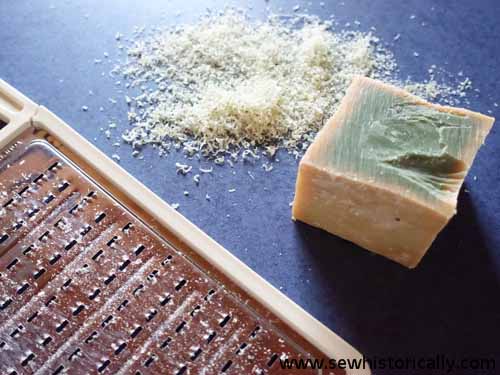
Chalk and Charcoal Tooth Powder (The Woman’s Own Book of Toilet Secrets, ca. 1896)
‘To keep the teeth white and pearly.’
- 1/2 oz powdered Peruvian bark
- 1/2 oz powdered prepared chalk
- 1/2 oz powdered myrrh
- 1/4 oz powdered orris root
- 1 oz finely powdered charcoal
‘Brush the teeth every night with a little warm salt water and every morning with the powder. It hardens the gums, preserves the teeth, gives them a beautiful polish, makes the breath pure and sweet.’
Camphor Tooth Powder (Health And Beauty Hints, 1910)
- 7 drams precipitated chalk
- 1/2 dram powdered camphor
- 1 dram powdered orris root
- optional: 1/2 dram powdered Castile soap
‘Mix by sifting serveral times through coarse muslin.’
Baking Soda Tooth Powder (Health And Beauty Hints, 1910)
- 1/4 oz bicarbonate of soda
- 1/4 oz powdered talc
- 3 drops lavender oil
To mix, sift it many times.
Premium Tooth Powder (A Perpetual Calendar: With Notes and Explanations on Chronology, Chronological Cycles and Other Useful Information, 1896)
- 6 oz prepared chalk
- 1/2 oz cassia powder
- 1 oz orris
Orris Root Tooth Soap (Henley’s Twentieth Century Formulas, Recipes And Processes, 1916)
- 225 parts white castile soap
- 225 parts precipitated chalk
- 225 parts orris root
- 7 parts oil of peppermint
- 4 parts oil of cloves
- a sufficient quantity water
Rose Water Tooth Soap (Henley’s Twentieth Century Formulas, Recipes And Processes, 1916)
- 100 drachms castile soap
- 100 drachms precipitated chalk
- 100 drachms orris root
- 50 drachms white sugar
- 50 drachms rose water
- 100 drops oil of cloves
- 3 drachms oil of peppermint
‘Dissolve the soap in water, add the rose water, then rub up with the sugar with which the oils have been previously triturated, the orris root and the precipitated chalk.’
Cherry Tooth Paste (Henley’s Twentieth Century Formulas, Recipes And Processes, 1916)
- 100 drachms clarified honey
- 100 drachms orris root
- 60 drops powdered rose leaves
- 55 drops oil of cloves
- 55 drops oil of mace
- 55 drops oil of geranium
How To Make Vegetable Tooth Brushes (The Cyclopædia of Practical Receipts in All the Useful and Domestic Arts, 1841)
‘Take marine marsh-mallow-roots, cut them into length of five or six inches, and of the thickness of a middling rattan cane. Dry them in the shade, but not so as to make them shrivel. Next finely pulverize two ounces of good dragon’s blood, put it into a flat-bottomed glazed pan, with four ounces of highly-rectified spirit, and half an ounce of fresh conserve of roses. Set it over a gentle charcoal fire, and stir it until the dragon’s blood is dissolved; then put in about thirty of the marsh-mallow sticks; stir them about, and carefully turn them, that all parts may absorb the dye alike. Continue this until the bottom of the pan be quite dry, and shake and stir it over the fire, until the sticks are perfectly dry and hard.
Both ends of each root or stick should, previous to immersion in the pan, be bruised gently by a hammer, for half an inch downwards, so as to open its fibers, and thereby form a brush. They are generally used by dipping one of ends in the powder or opiate, and then, by rubbing them against the teeth, which they cleanse and whiten admirably.’
Skewer-Brush (The Lady’s Guide to Perfect Gentility, 1856)
‘A butcher’s skewer, or the wood with which one is made, must be bruised and bitten at the end, till with a little use it will become the softest and best brush for this purpose, and, in general, needs only to be dipped in pure water, without any powder whatever; and once in a fortnight, or oftener, the skewer-brush may be dipped in a few grains of fine gunpowder; this will remove any spot and blemish, and give your teeth an inconceivable whiteness […] the mouth must be well washed after this operation’.
Rinse After Eating Acids (Health And Beauty Hints, 1910)
After eating food which contains acids, such as fruits, rinse your mouth with lime or soda water.
- 1 teaspoon dry bicarbonate of soda
- 1 cup water
Use this rinse as soon as possible after eating, as well as every evening.
How Often Should You Brush Your Teeth (The Washington Herald, 1908)
‘The teeth should be brushed after every meal, if possible; if not, at least once a day.’
How To Brush The Teeth (Household Companion: Book Of Etiquette, 1909)
‘Teeth should not be brushed too long at a time. Doing this injures the gums, and in this way the teeth may be loosened. The upper teeth should be brushed from above downwards (from the gums toward the edges), the lower teeth from below upwards. The inside of the teeth should be as carefully brushed as the outside.’
Dental Floss (Health And Beauty Hints, 1910)
Use dental floss, made of coarse, soft silk, every evening. ‘A substitute for the floss is any soft, white embroidery silk, waxed.’
Brushing Teeth With Soap (Household Companion: Book Of Etiquette, 1909)
‘It is sufficient to brush the teeth with soap two or three times each week (without interfering with the daily cleansing). For this a very pure soap should be used. It is not an agreeable process, but one soon becomes used to it, and the results are very desirable. Soap contains alkali, and alkalies are highly recommended for the teeth. They are antiseptic, and, therefore, very useful for the mouth. Soap removes the deposits on the teeth, which many of the most famous powders do not, except by destroying the enamel which protects them.’
Victorian Tooth Care (The Lady’s Guide to Perfect Gentility, 1856)
Brush the teeth every morning ‘with a brush dipped in water, scrub them well inside and out, rubbing them horizontally, vertically, and in every direction […] rinse the mouth with lukewarm water, and clean the tongue.’ Also brush the teeth after every meal ‘and rinse the mouth; repeat this always just before retiring.’
1920s Tooth Care (A Girl’s Problems In Home Economics, 1926)
Teeth are brushed in the evening and after every meal. See a dentrist regularly.

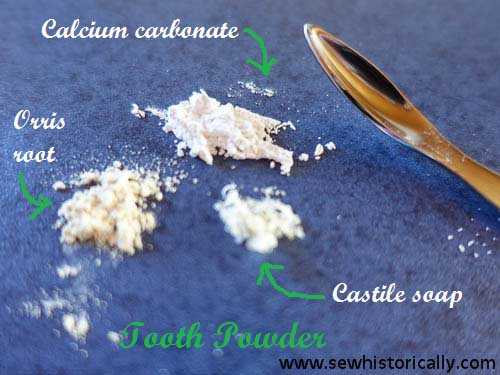
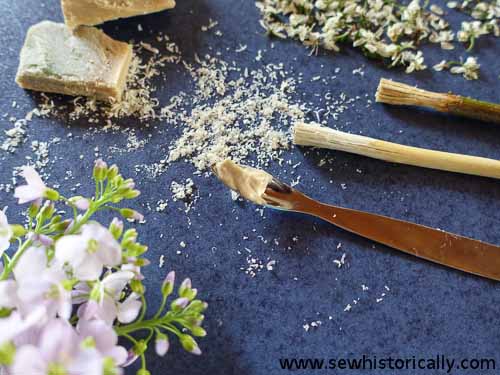
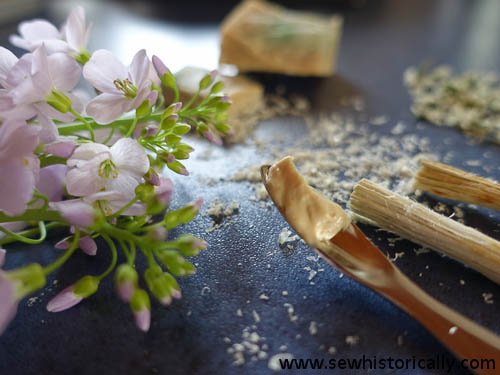
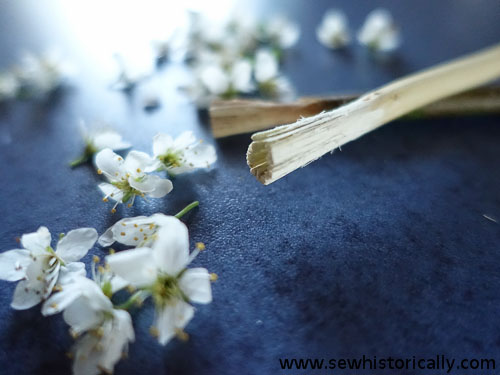

I have been experimenting a bit with DIY toothpaste and I like your recipes. The big problem for me is trying to find someone safe and useful to give it “slip”. Have you tried honey? It’s in a recipe on this page. As long as it’s not blended with water it should stay safe. I really appreciate all the effort you’ve put in to not only researching but presenting all the information beautifully.
Thank you! 😀 I haven’t made toothpaste with honey yet: I’d be worried about the sugar content of honey and dental health. But maybe this Edwardian toothpaste recipe is something for you. 🙂